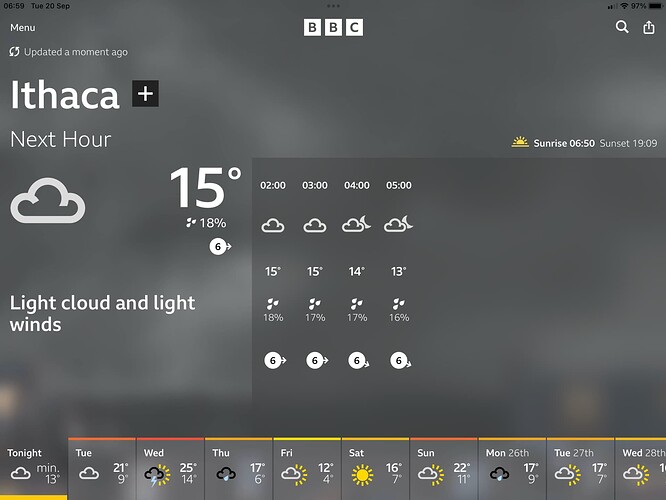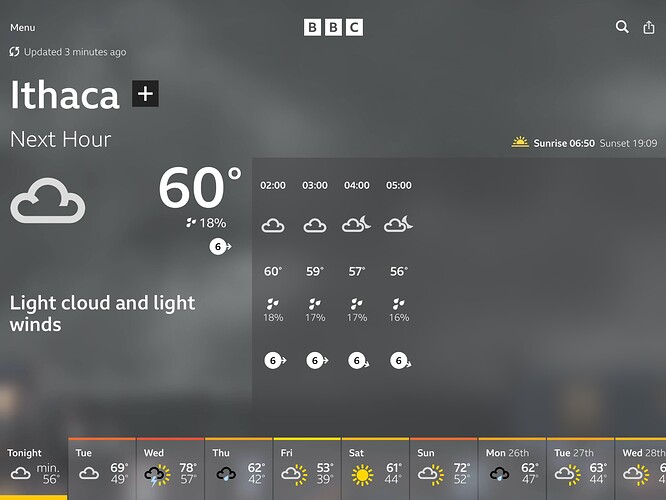I rely mostly on NOAA. There is a huge amount of data available, including hourly histories, radar, etc. I can pinpoint my exact location and forecast and current temps/winds are adjusted accurately. I also rely heavily on radar apps (Weather Radar and MyRadar) to track rain/snow activity — I can tell instantly if rain is imminent at my house and for how long. That’s important living in the mountainous boonies where access in/out is affected by weather. Best of all, as noted, the NOAA data is free. The radar apps are nominal.
Hi Adam. I am in one of those tricky weather areas in Scotland where the changes over five or six miles are significant and Apple Weather was never reliable. I use weather apps for hill climbing and for construction sites. Dark Sky was better but I find I need to use two apps to gauge what’s really going on. These are Yr.no Yr.no on the App Store and WeatherPro but I do not subscribe to a two week forecast as the reliability rarely extends beyond three or four days. If you like to have free or low cost apps, these work well here. atb Drew
Long been a fan of Carrot, although I can only deal with mildl snarky lol ![]()
In the UK, Apple’s Weather app is pretty useless. It doesn’t seem to be granular enough for our country of a thousand micro-climates. My recommendations for here are the free BBC Weather or Met Office apps. On my occasional visits to Switzerland, I have found the same and recommend the free MeteoSwiss app. Maybe it is expecting too much for one weather app to work well all over the world?
There’s essentially two sorts of weather forecasting app - those that serve forecasts, generally using data from national agencies worldwide, and those that supplement those forecasts with rain radar prediction to provide what Adam calls hyperlocal forecasting. The latter are very good at alerting you to rain within a couple of kilometres or so, but can only serve this up for around 3-6 hours ahead.
There’s hundreds of examples of both varieties - testament to the availability of the data, so it really comes down to an interface and presentation of data that works for you.
Personally, I use Weatherplaza, which I find generally very reliable and gives rain alerts about an hour ahead.
But remember all weather apps are only as good as the data they access and the algorithms interpreting those data. None are 100% accurate.
Apple’s Weather includes a “Feels Like” prediction, but what exactly is that? Is it dew point? I’ve always found dew point to be the most reliable indicator of how I’m going to feel. But digging around out there I could find no info on how “Feels Like” is calculated.
So what are the privacy track records of these weather apps? I seem to remember a minor furor over just how much data some of these apps were selling to third parties. I guess I trust Apple on this more than I trust, say, Weather Channel, but I’m not sure even Apple’s hands are clean on this.
I use MyRader Pro as my goto weather app. I loved Dark Sky but alas, no more I guess.
Anyhow, MyRadar and looks much like the Carrot interface with all the color enhancement. Carrot is a little expensive, and I don’t think they have learned how to share their license across iPhone, and Apple TV yet. I love weather apps, but I don’t want to pay by platform. The new Apple Weather is chock full of features, but looks a little drab to me. My 2 cents.
Feels like should be a combination of humidity, temp and dew point.
Diane
But dew point already is a combination of humidity and temperature.
Dew point is temp at which air (at same barometric pressure) becomes saturated with water vapor (i.e. 100% humidity). Assuming pressure constant, it can be calculated by current temp and humidity.
Feels like temp (“Heat Index”) is an attempt to adjust temp to account for the fact that we feel hotter in humid weather due to our evaporative cooling (perspiration). Note, perspiration has more to do with the wet-bulb temperature than dew point actually. And wet bulb, in a sense, is the counterpart of dew point. Instead of asking how low temps could get before humidity condensates, you’re asking how low something can be cooled by evaporating moisture into ambient air. If humidity reaches 100%, you can no longer evaporate and hence you can’t cool below ambient.
FWIW, I’ve always liked the forecasts from AccuWeather.
I deleted their mobile app year ago because they were tracking all kinds of data unrelated to weather (e.g. browsing history), probably for their advertisers. Apple’s privacy report indicates that they are no longer doing this, but I haven’t bothered reinstalling it, since the experience I get by just bookmarking the web site is good enough for me.
In other words, when the temperature drops below the dew point, water will condense out of the air. In other words, dew (or frost, if it’s cold) will form on surfaces. Which is a good way to remember what the term means (and probably how it was coined).
I believe that “feels like” also incorporates wind chill.
This is weather underground’s explanation: Feels Like Temps | Temperature Maps | Weather Underground
It’s amusing how the different weather apps disagree over forecasts for rural areas such as the one where I live. I find that for local weather the most accurate one is Weather Underground, which is free. You can search and find local (amateur) electronic weather stations, within a mile or three no matter where you are, that have locked into the weather underground network, and that report temperature, humidity, rainfall, wind, etc. to a degree of accuracy unmatched by other apps. Their forecasts are borrowed from The Weather Channel, and are more accurate than most. For storms and hyperlocal forecasts, Storm Radar is the most accurate in my rural area of New England. I’ll try Apple’s new Weather app to see if it’s any better than the others. Until now I haven’t much used it.
Dew point is reported on the humidity card. If you tap the card to see the forecast graph and pick any point on it, the dew point associated with that point will also be reported.
It would be nice if dew point got its own card, or if it appeared as a 2nd scale and line on the humidity graph.
Excellent – good to know! Thanks for the tip.
@heronlen: Do you have an App Store link for this? I can’t seem to track it down in the US store. Lots of other BBC apps, but haven’t found Weather.
Thanks.
I feel like the Apple Weather app in iOS 16 is missing the “Percentage chance of precipitation” by hour that the Dark Sky one has. Am I missing something? You used to be able to see “oh, ok 75% chance of light rain at 2 PM and 5% chance at 10 AM. Guess I’ll go for hike at 10.” But in Weather now, it shows you a graph representing amount of rain at a particular hour and you can swipe around to see it go from 0" to .05" to .25" etc. There’s no “likelihood” or “percentage” of that rainfall happening. Does that mean it’s 100% likely we’ll get .05" rain at 2 PM? Maybe I am missing the % likelihood somewhere in the new interface? HOPING SO!
Also now we have to know if a certain amount of rain is a lot? Dark Sky tells you “light rain” or “heavy rain” etc so you don’t have to be a weather nerd to know if .05 is a lot or not.

